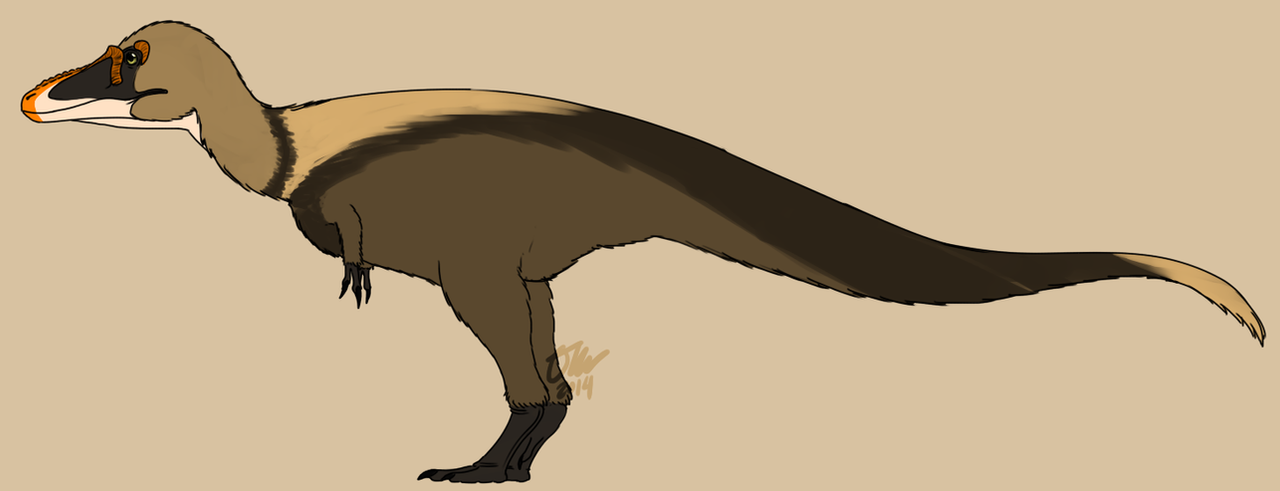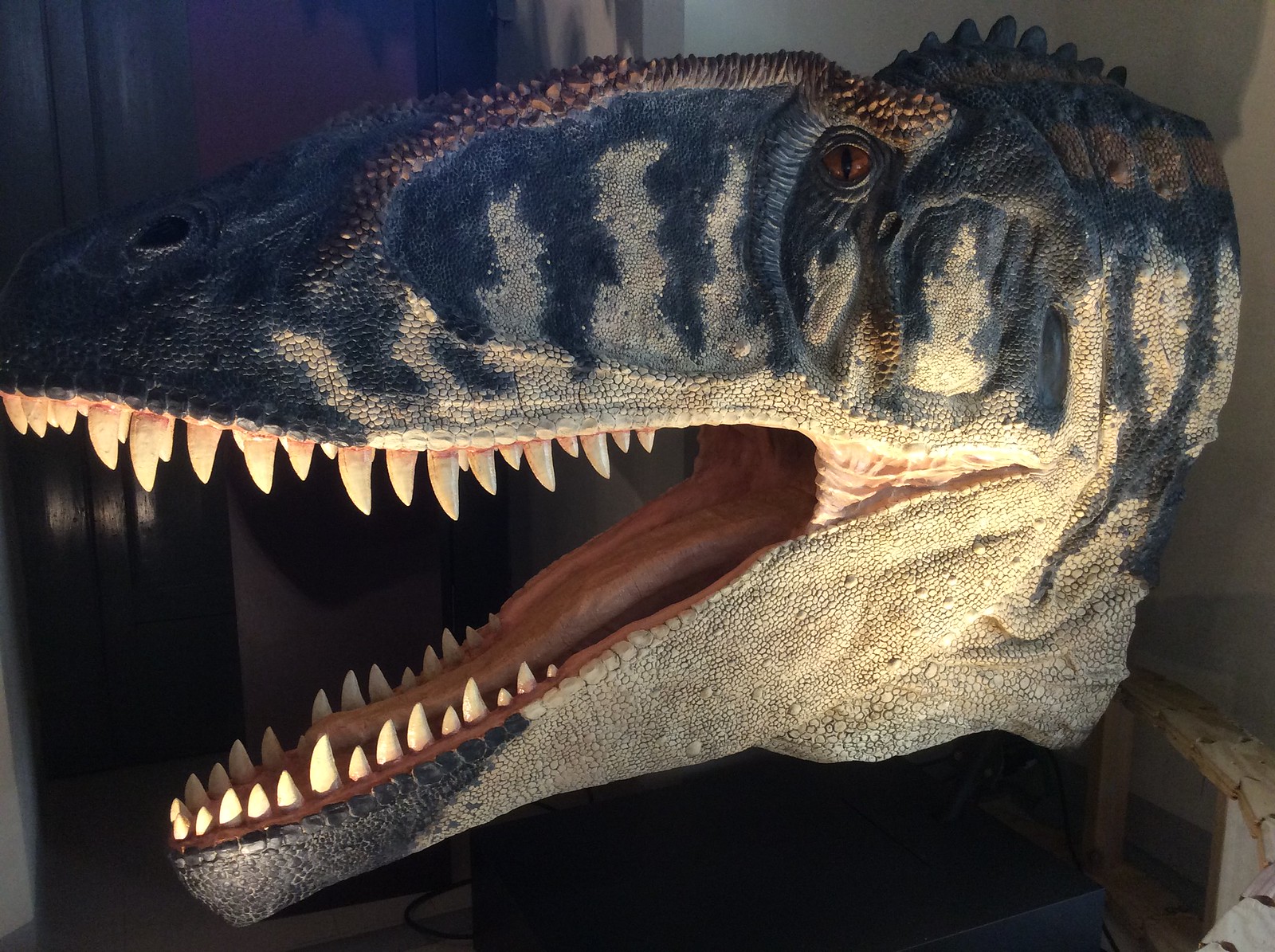Post by Infinity Blade on Feb 22, 2015 8:33:39 GMT 5
Nanuqsaurus hoglundi
Nanuqsaurus (meaning "polar bear lizard") is an extinct genus of carnivorous tyrannosaurid theropod known from the Late Cretaceous (early Late Maastrichtian stage) Prince Creek Formation of the North Slope of Alaska. It contains a single species, Nanuqsaurus hoglundi, known only from a partial skull. Nanuqsaurus has been estimated to have been about six meters (twenty feet) long, about half the length of Tyrannosaurus rex. This dimunitive size was postulated by Fiorillo and Tykoski as being an adaptation to its high latitude habitat. Nanuqsaurus bears a particularly shaped ridge on its head indicating the carnivore was related to Tyrannosaurus rex. The length of the reconstructed skull, based on the proportions of related animals, is 60–70 cm (24–28 in). Classified as a tyrannosaurine, Nanuqsaurus is diagnosed by: a thin, rostrally-forked, median spur of the fused parietals on the dorsal skull roof that overlaps and separates the frontals within the sagittal crest, frontals with a long, rostrally-pointed process separating the prefrontal and lacrimal facets and that the first two dentary teeth are much smaller than the dentary teeth behind them.

© @ MicrocosmicEcology
Qianzhousaurus sinensis
Qianzhousaurus is a genus of tyrannosauridae dinosaur. There is currently only one species named, the type species Qianzhousaurus sinensis. Nicknamed "Pinocchio rex" for its long snout in comparison to other known tyrannosaurs, it was discovered in southern China and first published in the journal Nature Communications in May 2014. Aside from its signature snout, it also had long, narrow teeth, while T. rex had thick teeth and powerful, deep-set jaws. The bones were discovered by workmen at a construction site near the city of Ganzhou, who then took them to a local museum. Lead author Professor Lü Junchang from the Institute of Geology, Chinese Academy of Geological Sciences stated that "the new discovery is very important. Along with Alioramus from Mongolia, it shows that the long-snouted tyrannosaurids were widely distributed in Asia. Although we are only starting to learn about them, the long-snouted tyrannosaurs were apparently one of the main groups of predatory dinosaurs in Asia." The existence of long-snouted tyrannosaurs was previously suspected due to other inconclusive fossil finds, that could be explained as the juveniles of short-snouted species, but co-author Stephen L. Brusatte from the University of Edinburgh reveals that the find "tells us pretty unequivocally that these long-snouted tyrannosaurs were a real thing. They were a different breed, living right at the end of the age of dinosaurs." Examination of the rock encasing the Fossil shows it is probably from the Red Beds of the Nanxiong Formation, which date to the Cretaceous–Paleogene boundary about 72-66 million years ago.

© @ StygimolochSpinifer
Nanuqsaurus (meaning "polar bear lizard") is an extinct genus of carnivorous tyrannosaurid theropod known from the Late Cretaceous (early Late Maastrichtian stage) Prince Creek Formation of the North Slope of Alaska. It contains a single species, Nanuqsaurus hoglundi, known only from a partial skull. Nanuqsaurus has been estimated to have been about six meters (twenty feet) long, about half the length of Tyrannosaurus rex. This dimunitive size was postulated by Fiorillo and Tykoski as being an adaptation to its high latitude habitat. Nanuqsaurus bears a particularly shaped ridge on its head indicating the carnivore was related to Tyrannosaurus rex. The length of the reconstructed skull, based on the proportions of related animals, is 60–70 cm (24–28 in). Classified as a tyrannosaurine, Nanuqsaurus is diagnosed by: a thin, rostrally-forked, median spur of the fused parietals on the dorsal skull roof that overlaps and separates the frontals within the sagittal crest, frontals with a long, rostrally-pointed process separating the prefrontal and lacrimal facets and that the first two dentary teeth are much smaller than the dentary teeth behind them.

© @ MicrocosmicEcology
Qianzhousaurus sinensis
Qianzhousaurus is a genus of tyrannosauridae dinosaur. There is currently only one species named, the type species Qianzhousaurus sinensis. Nicknamed "Pinocchio rex" for its long snout in comparison to other known tyrannosaurs, it was discovered in southern China and first published in the journal Nature Communications in May 2014. Aside from its signature snout, it also had long, narrow teeth, while T. rex had thick teeth and powerful, deep-set jaws. The bones were discovered by workmen at a construction site near the city of Ganzhou, who then took them to a local museum. Lead author Professor Lü Junchang from the Institute of Geology, Chinese Academy of Geological Sciences stated that "the new discovery is very important. Along with Alioramus from Mongolia, it shows that the long-snouted tyrannosaurids were widely distributed in Asia. Although we are only starting to learn about them, the long-snouted tyrannosaurs were apparently one of the main groups of predatory dinosaurs in Asia." The existence of long-snouted tyrannosaurs was previously suspected due to other inconclusive fossil finds, that could be explained as the juveniles of short-snouted species, but co-author Stephen L. Brusatte from the University of Edinburgh reveals that the find "tells us pretty unequivocally that these long-snouted tyrannosaurs were a real thing. They were a different breed, living right at the end of the age of dinosaurs." Examination of the rock encasing the Fossil shows it is probably from the Red Beds of the Nanxiong Formation, which date to the Cretaceous–Paleogene boundary about 72-66 million years ago.

© @ StygimolochSpinifer








